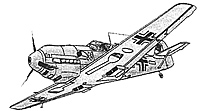 Aerial warfare in WWII has always been interesting to me. Although computer games were fun, I wanted to play a wargame with models. Unfortunately, the rules I considered were too complex and slow, so I decided to make my own.
Aerial warfare in WWII has always been interesting to me. Although computer games were fun, I wanted to play a wargame with models. Unfortunately, the rules I considered were too complex and slow, so I decided to make my own.
Simplicity was the key word in the development of “B-17!” Large bomber formations were reduced to a simple box of four B-17s. Washers painted different colors to represent various altitude levels were scrapped. Hexes and turning templates bit the dust, too-all in the name of simplicity.
The heart of the game is very simple. The attacking and defending fire of fighters and bombers, the dogfighting and the bombing are all based on the DBA combat mechanism. It can’t get much simpler than that. Most people are already familiar with DBA and it doesn’t take long to figure out the rest.
The “B-17!” rules present three scenarios that allow the player to learn the game in steps. After the player becomes familiar with the rules, the first scenario should take about 35 minutes, the second about 45 minutes, and the third scenario about two hours.
 Playtesting the game was difficult because I did not know anyone else who was interested. Fortunately, I saw an article in the Lone Warrior written by Lars Boye of Denmark that listed all of the airwar boardgames that could be played solo. Here was an expert on the subject and his e-mail address was listed in the article. Lars graciously agreed to give the rules a try. The result was many good suggestions. In fact, so many of his suggestions were incorporated into the rules that he should be considered the co-author.
Playtesting the game was difficult because I did not know anyone else who was interested. Fortunately, I saw an article in the Lone Warrior written by Lars Boye of Denmark that listed all of the airwar boardgames that could be played solo. Here was an expert on the subject and his e-mail address was listed in the article. Lars graciously agreed to give the rules a try. The result was many good suggestions. In fact, so many of his suggestions were incorporated into the rules that he should be considered the co-author.
The game was designed to be played with 1/285th scale metal aircraft or with homemade paper models. (Creating the paper models was as much fun as making the rules.) The paper models were supposed to be 1/285th scale, but they were so hard to cut out and handle that I made them larger for convenience. I also made jointed paper rulers to speed up aircraft movement. You may make a simple map for the target, but a piece of blank paper will work as well. If you want to color the planes, Prismacolor pencils would work best, or I will send colored graphics by e-mail to anyone who can open an MS Word attachment.
Two photocopies of the black and white models in this article will provide all the planes needed for the three scenarios. The following suggestions may help in the assembly process.
Print the graphics on card stock.
Whether you are photocopying the black and white models in this article or using the colored models from an MS Word attachment, the graphics should be printed on white card stock paper. I found a package of 150 sheets for $5.00 in the stationary section of the local Wal-Mart. (I think people use it to make business cards on their computers.) You can find the rubber cement at Wal-Mart, too. It costs $1.37 a jar. In fact, I bought a pair of scissors at Wal-Mart for less than $4.00 that work better than any others.
Score all of bends before you cut out the models.
Use a stylus or a dried up ballpoint pen to score where the wings and stabilizers bend away from the fuselage. The B-17 will be bent through the length of the fuselage. Score it on the black line that runs from the nose to the tail. On the fighters, be sure to cut the lines on the horizontal stabilizers up into the fuselage to the bending line so they will bend out correctly.
Use rubber cement to glue the models together.
If you put cement on both sides before joining them, the bond will be much more secure. If you have an excess of rubber cement, the models will tend to stick to one another during storage. If this bothers you, an inexpensive rubber cement remover (crepe-latex) shaped like an art gum eraser may be bought in art stores. (The last one I bought cost around $1.25.) This will remove most of the dried excess very quickly and easily.
More B-17
Back to Table of Contents -- Lone Warrior #138
Back to Lone Warrior List of Issues
Back to MagWeb Magazine List
© Copyright 2002 by Solo Wargamers Association.
This article appears in MagWeb (Magazine Web) on the Internet World Wide Web.
Other military history articles and gaming articles are available at http://www.magweb.com
